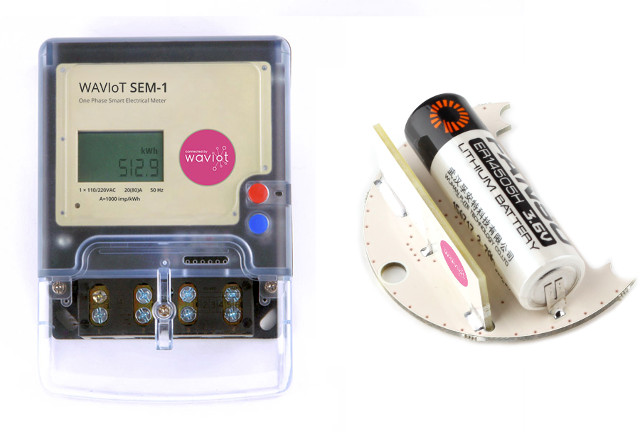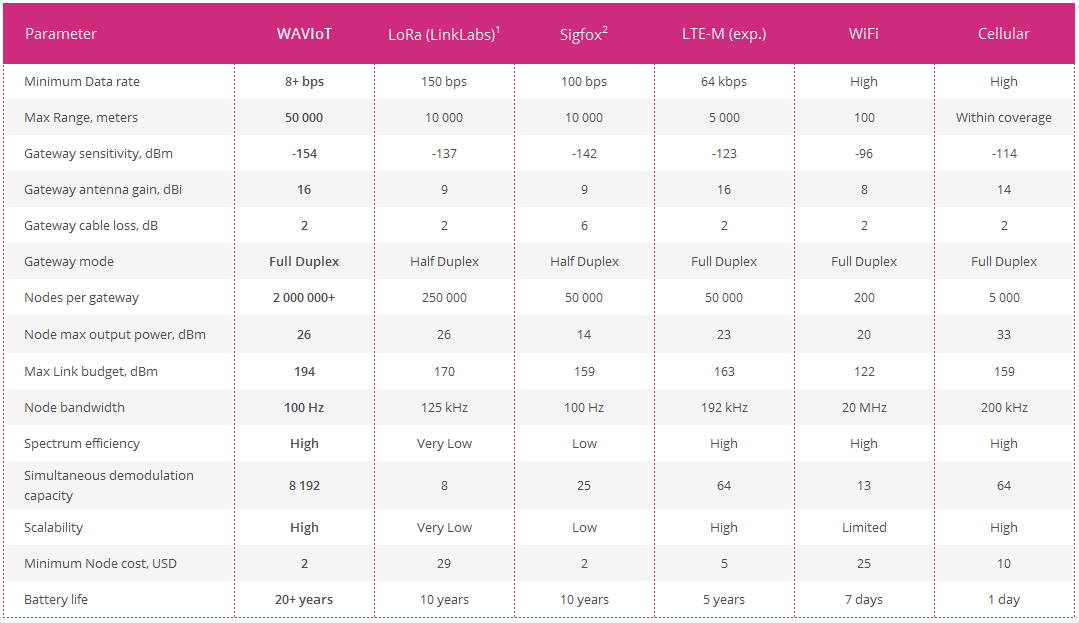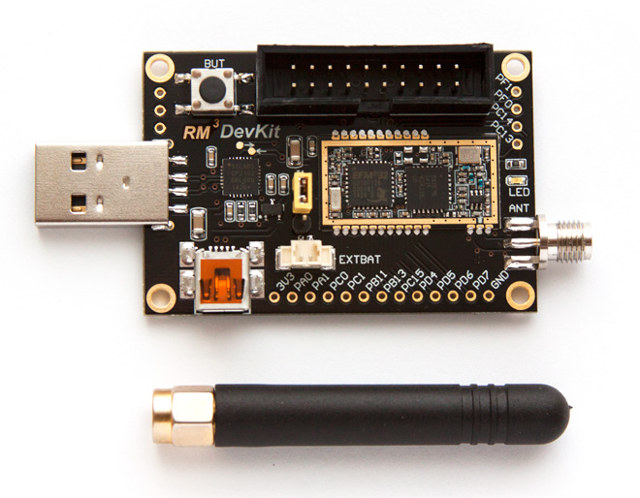With the rise of IoT and M2M applications, more and more Low Power Wide Area Network (LPWAN) standards have been launched or being worked on, such as Sigfox, LoRa, 802.11ah “Hallow”, Weightless, etc… with all promising long range, low power consumption, and support for a high number of nodes. WAVIoT, a US startup founded in 2011, has decided to create its own solution called WAVIoT Nb-Fi (Narrowband Fidelity) that works in ISM bands, offers up to 50km line-of-sight range, supports up to 2 million nodes by gateway, lasts over 20 years on a small battery, and with WAVIoT said to cost as low as $2 per node. The technology is already available in smart electricity and water meters, and modules as shown in the picture below.
 Here are some of WAVIoT Nb-Fi technical specifications:
Here are some of WAVIoT Nb-Fi technical specifications:
- DBPSK on physical layer of signal transmission;
- End-nodes transmit radio signal in 10-500 kHz bandwidth
- Minimum bit rate of 50 baud+ (8-10 bits per second)
- Link budget available 184-194 dBm
- Output power up to 25dBm (with FEM)
- TX 250mA @ 27Bm, 90mA @ 16dBm, 44mA @ 14dBm
- Sleep mode with RAM retention and wake-up timer running 1.5 μA
- RF transceiver operates over a wide frequency range including 315MHz, 433MHz, 470MHz, 868MHz, 915MHz in the license-free Industrial, Scientific and Medical (ISM) frequency bands.
But the best way to see what the standard can do it to compare it to other solutions such as LoRa, Sigfox, LTE-M, WiFi, and Cellular.

(1) LoRa info source: Link Labs; (2) Sigfox info source: SigFox.
The table above has been provided by the WAVIoT, and while it’s informative, the data shown is likely to show WAVIoT Nb-IF in the best light possible.
You can already setup an ecosystem with WAVIoT, for example using WAVIoT GW200 base station combined with nodes using RM130 transceiver module ($15) supporting both Nb-Fi and LoRa, or smart meters such as SWM-1 smart water meter ($28) or SEM-1 smart electricity meter ($59).

The company also provides a WAVIoT and LoRa development kit based on RM-130 transceiver module with the following hardware specifications:
- MCU – SiLabs EFM32G210F128 ARM Cortex-
M3 MCU @ 32 MHz with 128 KB Flash and 16 KB RAM - RF Transceiver – Semtech SX1276 137 MHz to 1020 MHz Low Power Long Range Transceiver
- Frequency Bands – 866.5 – 916.5 MHz
- Radio protocols – LoRa, WAVIoT UNB
- TX Power Range – -2…18.6 dBm, by 1 dBm steps
- TX Current – 120mA @ 18.6dBm, 90mA @ 16dBm
- RX Current – 16 mA
- Sleep Current 10 µA
- Expansion – 17 through holes for Power signals, as well as GPIO, USB, UART, SPI, I2Cm ADC, analog comparators, pulse counters, etc…
- Debugging – 20-pin JTAG header, USB-UART interface
- Power Supply – 5V via USB or 2.5 / 3.8V (selectable by jumper)
- Dimensions – 80 × 38 × 11mm
- Operating Temperature – – 40…85 °C
So WAVIoT is just using existing RF solutions, and seems to basically use the same hardware as LoRA, as Semtech SX1276 is featuring a “LoRa long range modem”, and the cost per node is likely lower because of its better scalability. The board supports add-on shields for LCD display, SWR sensor, and more.
The company provides a simple Windows GUI, command-line utilities for Windows, Linux, and Mac OS X, and an open source host-interface abstraction written for PCs and embedded microcontrollers. Several cloud solutions for data management and billing are offered. The development kit sells for $274.99.
You can find more details on WAVIoT website.

Jean-Luc started CNX Software in 2010 as a part-time endeavor, before quitting his job as a software engineering manager, and starting to write daily news, and reviews full time later in 2011.
Support CNX Software! Donate via cryptocurrencies, become a Patron on Patreon, or purchase goods on Amazon or Aliexpress





My only problem with these kinds of low power transmission standards is that most require a base station and are designed to be all connected to that base station. It would be nice to have something that would run for 1000 m or less but would support point to point.
I’m hoping Halo will bring cheaper gateways at least.
@Marius Cirsta
Lora can operate p2p without loramac. Just not marketed that way.
@Marius Cirsta
also i juz did a quick look on their site
“10+ miles data transmission range in urban and 20+ miles in open country” & “500,000 endpoints per gateway”
Over 20 year on coin cells ? I think the coin cell will be discharged itself in such long period.
I contact with WAVIO – no public app notes, examples and other (as Semtech). Looks strange.
Marius,
See the solution built by IoTMesh. More or less the same solution but base station is not mandatory. You can build your own system.
http://www.iotmesh.eu
Gaëtan
@Marius Cirsta
Try to look also on Dash7 protocol, it makes it possible to even swich endpoint to gateway mode (if you have enouph energy, lol).
Also, D7 is one of rare non-proprietary protocols, with widely-spreaded hw from lots of hw manufacturers, and as i know, the only one flexible.
Yes… But Dash7 is only for 433Mhz… no?
I contacted them about pricing on the gateway. This was their response:
The prices for all items are available on a web-site. You can find wholesale prices wich make a massive IoT application roll out a really cost effective.